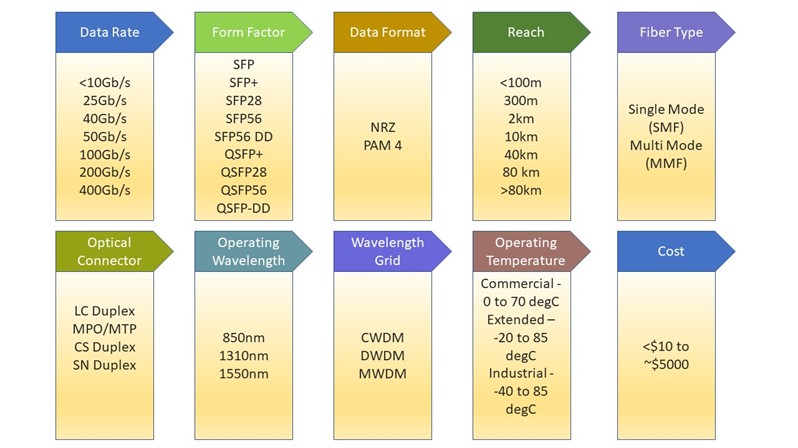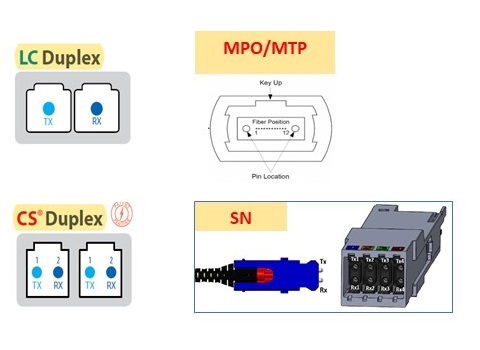Demand for network bandwidths is increasing daily and it feels like there is a different optical transceiver in the market every few weeks. With so many flavors of transceivers, the choices can boggle the mind.
To help you make an informed choice, we have listed key parameters to consider when choosing an optical transceiver:

Data Rate and Form Factor: The multi-source agreement (MSA) defines the different transceiver form factors. Popular form factors include SFP+, SFP28, QSFP+, QSFP28, QSFP56 and so on. Different switching equipment support different data rates and data formats. Always ensure that your transceiver is compatible with your network switch.
Data Format : NRZ is the preferred encoding scheme for 28 Gbps rates. PAM4 has become the standard for medium and long distance data transmission where each link transmits 50 to 56 Gbps per lane.
The image below shows the difference in eye between NRZ and PAM4 modulation.


Reach and Fiber Type: A singular advantage of fiber over copper is the distance a signal can be transmitted over fiber. The reach also defines the type of fiber to be used, with multi-mode being used for shorter reaches and single mode for long reaches.
Connectors: The most common types of fiber cable connectors used in optical transceivers and networks are LC and MPO/MTP though there are some new types of connectors available now.

LC duplex: This is a connector that everyone is familiar with. LC duplex is widely used in 40G and 100G transceivers.
MPO/MTP Connectors: These can be 8/12/24 fiber and are most commonly used in 40G, 100G and 400G transceivers.
CS Duplex: CS is a new connector type typically used in 200G and 400G transceiver connections. The reduced size allows double the density in patch panels compared to a LC connector.
SN connector: This is designed primarily for OSFP/QSFP-DD and allows four duplex connections in a QSFP-DD/OSFP without using a separate fan-out.
Operating Wavelengths: 850nm, 1310nm and 1550nm are the prime wavelengths used in fiber optics transmission.
850nm : Typically used in short distance multi-mode fiber connections below 500m.
1310nm : Used in Single Mode, generally used for transmission for high data rate transmission.
1550nm : Used in single mode long reach links at data rates below 10Gbps because of its low attenuation. Beyond 10Gbps modulation, 1550nm is hardly used due to its’ unacceptably high fiber dispersion. For higher speed modulations, 1310nm is the wavelength of choice for 40km and 80km links.
Wavelength grids: WDM (Wavelength Division Multiplexing) technology allows for transmission of multiple wavelengths over one fiber using different wavelengths.
CWDM : CWDM (Coarse Wavelength Division Multiplexing) fiber transceivers support wavelengths ranging from 1270nm to 1610nm with a spacing of exactly 20nm. Each channel uses a different color.
DWDM : DWDM (Dense Wavelength Division Multiplexing) can accommodate 40, 80 or even 160 wavelengths with narrower wavelength spans which are as small as 0.8nm, 0.4nm or even 0.2nm.
This article discusses CWDM and DWDM transceivers in detail
MWDM: MWDM (Medium Wavelength Division Multiplexing) used in 5G networks is relatively new technology. It is based on the 6 wavelengths of CWDM, shifted by 3.5nm left and right to expand to 12 wavelengths (1267.5, 1274.5, 1287.5, 1294.5, 1307.5, 1314.5, 1327.5, 1334.5, 1347.5, 1354.5, 1367.5, 1374.5nm).
Operating Temperature Range : Standard operating voltage of an optical transceiver is 3.3V. Most applications need only commercial temperature transceivers at 0 to 70 degC. Vitex also offers extended ( -20 to 85degC) and industrial temperature (-40 to 85 degC) transceivers for outdoor and rugged applications.
Cost: Cost is a critical factor in transceiver selection. Low data rate transceivers can cost under $20, while you end up paying a few thousands for a 100G or 400G transceiver. Read this article to understand the many components that go into determining the cost of a transceiver.
Choosing the right optical transceiver requires careful consideration. Our experts can help you decide on an optimal transceiver for your application. Contact us at Vitex sales, sales@vitextech.com to talk to our engineers.
Related Products

